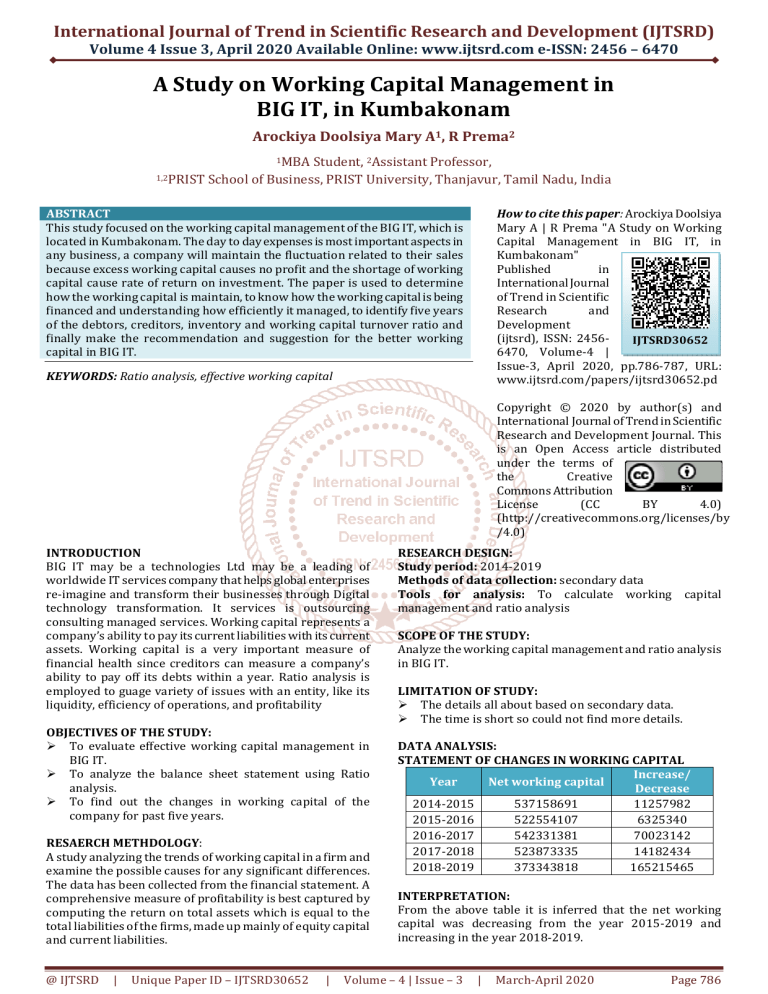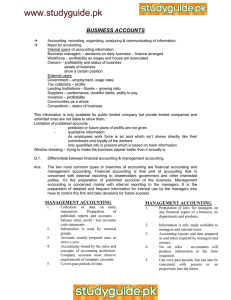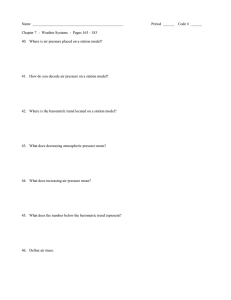
International Journal of Trend in Scientific Research and Development (IJTSRD) Volume 4 Issue 3, April 2020 Available Online: www.ijtsrd.com e-ISSN: 2456 – 6470 A Study on Working Capital Management in BIG IT, in Kumbakonam Arockiya Doolsiya Mary A1, R Prema2 1MBA Student, 2Assistant Professor, 1,2PRIST School of Business, PRIST University, Thanjavur, Tamil Nadu, India How to cite this paper: Arockiya Doolsiya Mary A | R Prema "A Study on Working Capital Management in BIG IT, in Kumbakonam" Published in International Journal of Trend in Scientific Research and Development (ijtsrd), ISSN: 2456IJTSRD30652 6470, Volume-4 | Issue-3, April 2020, pp.786-787, URL: www.ijtsrd.com/papers/ijtsrd30652.pd ABSTRACT This study focused on the working capital management of the BIG IT, which is located in Kumbakonam. The day to day expenses is most important aspects in any business, a company will maintain the fluctuation related to their sales because excess working capital causes no profit and the shortage of working capital cause rate of return on investment. The paper is used to determine how the working capital is maintain, to know how the working capital is being financed and understanding how efficiently it managed, to identify five years of the debtors, creditors, inventory and working capital turnover ratio and finally make the recommendation and suggestion for the better working capital in BIG IT. KEYWORDS: Ratio analysis, effective working capital Copyright © 2020 by author(s) and International Journal of Trend in Scientific Research and Development Journal. This is an Open Access article distributed under the terms of the Creative Commons Attribution License (CC BY 4.0) (http://creativecommons.org/licenses/by /4.0) INTRODUCTION BIG IT may be a technologies Ltd may be a leading of worldwide IT services company that helps global enterprises re-imagine and transform their businesses through Digital technology transformation. It services is outsourcing consulting managed services. Working capital represents a company’s ability to pay its current liabilities with its current assets. Working capital is a very important measure of financial health since creditors can measure a company’s ability to pay off its debts within a year. Ratio analysis is employed to guage variety of issues with an entity, like its liquidity, efficiency of operations, and profitability OBJECTIVES OF THE STUDY: To evaluate effective working capital management in BIG IT. To analyze the balance sheet statement using Ratio analysis. To find out the changes in working capital of the company for past five years. RESAERCH METHDOLOGY: A study analyzing the trends of working capital in a firm and examine the possible causes for any significant differences. The data has been collected from the financial statement. A comprehensive measure of profitability is best captured by computing the return on total assets which is equal to the total liabilities of the firms, made up mainly of equity capital and current liabilities. @ IJTSRD | Unique Paper ID – IJTSRD30652 | RESEARCH DESIGN: Study period: 2014-2019 Methods of data collection: secondary data Tools for analysis: To calculate working capital management and ratio analysis SCOPE OF THE STUDY: Analyze the working capital management and ratio analysis in BIG IT. LIMITATION OF STUDY: The details all about based on secondary data. The time is short so could not find more details. DATA ANALYSIS: STATEMENT OF CHANGES IN WORKING CAPITAL Increase/ Year Net working capital Decrease 2014-2015 537158691 11257982 2015-2016 522554107 6325340 2016-2017 542331381 70023142 2017-2018 523873335 14182434 2018-2019 373343818 165215465 INTERPRETATION: From the above table it is inferred that the net working capital was decreasing from the year 2015-2019 and increasing in the year 2018-2019. Volume – 4 | Issue – 3 | March-April 2020 Page 786 International Journal of Trend in Scientific Research and Development (IJTSRD) @ www.ijtsrd.com eISSN: 2456-6470 RATIO ANALYSIS: Current Year ratio 2015 3.54 2016 3.33 2017 3.49 2018 3.00 2019 2.42 Gross profit ratio 0.71 0.70 0.61 0.54 0.39 The current ratio, which is less than the standard norms that has been uniformly maintained in all the Five years. Net profit ratio 0.51 0.49 0.43 0.36 0.23 In general the working capital management of BIG IT has been on the decreasing side. By improving the ratios. INTERPRETATION: From the above table infrared current ratio and gross profit ratio and net profit ratio and is highest in the year 2015. FINDINGS: The current ratio, which is less than the standard norms that has been uniformly maintained in all the Five years. Schedule of changes in working capital has been decreasing from 2014-2015, it is due to increase in current liabilities and decrease in debtors. The grass working capital has been decreasing in the years 2015-2018. The net working capital has been decreasing in the years 2017-2018 SUGGESTIONS: Though the financial performance of the company is good. There is a decreasing trend in profit level, so the company must take necessary actions to increase its profit level. It is suggested that the company should try to generate maximum funds through operations and should reduce their dependence on borrowings for working capital. CONCLUSION: The study is focused on the working capital management using the ratio of BIG IT. The study reveals that the financial aspect of the company is satisfactory. @ IJTSRD | Unique Paper ID – IJTSRD30652 | REFERENCE: [1] Amarjit, Gill., Nahum, Biger., and Neil, Mathur. (2010). "The Relationship between Working Capital Management and Profitability: Evidence From The United States", Business and Economics Journal, Volume 2010, BEJ-10. [2] Lazaridis, Ionannis and Dimitrios Tryfonidis, 2006. “Relationship between Working Capital Management and Profitability of Listed Companies in the Athens Stock Exchange”, Journal of Financial Management and Analysis, Vol. 19, No. 1, pp. 26-35. [3] Mamoun, M., Al-Debi'e. (2011). "Working Capital Management and Profitability: The Case of Industrial Firms in Jordan", European Journal of Economics, Finance and Administrative Sciences, Issue 36, pp. 7586. [4] Mathuva D. M. (2009), “The Influence of Working Capital Management Components On Corporate Profitability: A Survey on Kenyan Listed Firms”, Research Journal Of Business Management, www.docsdrive.com/pdfs/academicjournals/rjbm/00 00/15988-15988.pdf. [5] Mohammad Neab and Noriza BMS. (2010), “Working Capital Management: The Effect of Market Valuation and Profitability in Malaysia”, International Journal of Business and Management, Vol. 5, No. 11, Page 140147. Volume – 4 | Issue – 3 | March-April 2020 Page 787



